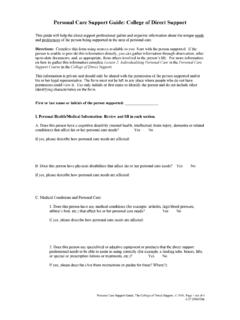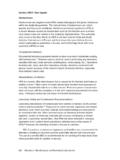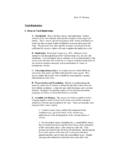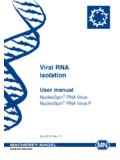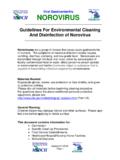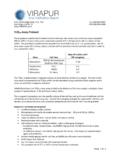Transcription of AListofCommonInfections VIRALINFECTIONS
1 A List of Common Infections viral INFECTIONS Acquired Immune Deficiency Syndrome (AIDs): AIDS is the final stage of HIV disease. It causes severe damage to the immune system. Initial symptoms include chills, fever, night sweats, swollen lymph nodes, weakness, and weight loss. Many people with AIDS will also get other illnesses more easily. This can include cancer. Chicken Pox: This is an infection that causes hundreds of blisters. Symptoms include a red, itchy rash on the face, scalp and back. It includes liquid filled blisters that break open and crust over. It can also include fever, abdominal pain, loss of appetite, irritability, dry cough, and a headache. Common Cold: This infection usually affects the nose and head.
2 Symptoms include a runny nose, nasal congestion, and sneezing. It may include a sore throat, cough, headache, or other symptoms. Hepatitis (A, B, C): This is a viral infection of the liver. Symptoms include pain in the abdomen, dark urine, and clay colored stools. It can also include fatigue, fever, yellowing of skin or eyes, loss of appetite, nausea and vomiting, and weight loss. Herpes Simplex (HSV): This is an infection with sores in the area where the virus enters the body. The sores turn into blisters. They can become itchy and painful. Then they heal. There are two types of herpes. One is oral herpes. This causes cold sores around the mouth or face. The other type is genital herpes. This affects the genitals, buttocks, or anal area.
3 Genital herpes is a sexually transmitted disease (STD). Human Immunodeficiency Virus (HIV): This is an infection that damages the immune system. Many people develop a brief flu- like illness. This happens two to four weeks after becoming infected. Early symptoms may include a fever, headache, sore throat, swollen lymph glands, and a rash. Long term symptoms can include mild infections or chronic symptoms. This includes swollen lymph nodes, diarrhea, weight loss, fever, and a cough or shortness of breath. Influenza (Flu): Influenza is a viral infection that attacks the respiratory system. This includes the nose, throat, and lungs. Symptoms include body aches, chills, dizziness, a flushed face, headache, lack of energy, nausea, and vomiting.
4 Measles: This is a very contagious infection. Symptoms include fever, dry cough, runny nose, sore throat, inflamed eyes, and sensitivity to light. It can also include tiny white spots with bluish- white centers found inside the mouth and a skin rash with large, flat blotches. Mumps: This is painful swelling of the salivary glands. Symptoms include face pain, fever, headache, sore throat, swelling of the glands behind the ear and jaw, and swelling of the temples. In males symptoms can also include a testicle lump, testicle pain, and scrotal swelling. Rabies: Rabies enters the body through a bite or broken skin. It is usually spread by infected saliva from a domestic or wild animal. Symptoms include anxiety, stress and tension, drooling, and convulsions.
5 It can include exaggerated sensation at the bite site, excitability, loss of feeling in an area of the body, and loss of muscle function. It can also include a low fever, muscle spasms, numbness or tingling, pain at the bite site, restlessness, and trouble swallowing. Rubella: This is also known as German Measles. It is a rash on the skin. Symptoms include a mild fever (under 102 F), headache, a stuffy or runny nose, and inflamed or red eyes. It can include enlarged and tender lymph nodes at the base of the skull, back of neck, and behind the ears. It can also include a fine, pink rash. This starts on the face and spreads quickly to the trunk, arms, and legs and then disappears. Severe acute respiratory syndrome (SARS): This is a form of pneumonia.
6 Hallmark symptoms include a cough, trouble breathing, a fever higher than , and other breathing issues. Common symptoms include chills and shaking, a cough, a fever, a headache, and muscle aches. Sexually transmitted diseases (STDs): This is an infection that is passed from one person to another during sex. Common STDs include chlamydia, genital herpes, genital warts, gonorrhea, hepatitis (A,B, C) and syphilis. Warts: These are small painless growths on the skin. Symptoms vary by the type of wart. Symptoms can include abnormally dark or light skin around a lesion or many small, smooth, flat lesions. It can include rough growths around or under finger or toenails. It can also include rough, round, or oral lesions on soles of feet or small, hard, flat or raised lesions on the skin.
7 West Nile Virus: This is an infection that is spread by mosquitos. Symptoms include abdominal pain, diarrhea, fever, headache, and loss of appetite. It can include muscle aches, nausea, rashes, a sore throat, swollen lymph nodes, and vomiting. More severe forms can include confusion, loss of consciousness or coma, muscle weakness, a stiff neck, and weakness of one arm or leg. BACTERIAL INFECTIONS Clostridium Djfficile (C. diff): This infection most commonly affects older adults in hospitals or in long term care facilities. It usually occurs after use of antibiotics. Symptoms include watery diarrhea several times a day for two or more days and mild abdominal cramping and tenderness. Some cases can be severe.
8 Severe symptoms include watery diarrhea 10- 15 times a day, abdominal pain and cramping, fever, blood or pus in the stool, nausea, dehydration, loss of appetite, and weight loss. Conjunctivitis (Pink Eye): This is an infection of the transparent membrane that lines the eyelid and part of the eyeball. It can be viral or bacterial. Symptoms include redness in one or both eyes, itchiness, a gritty feeling, discharge, and tearing. Impetigo: This infection usually happens when bacteria enters the skin through a cut or insect bite. Symptoms include red sores that quickly rupture, ooze for a few days, and then form a yellowish- brown crust. Other symptoms can include itching, fluid- filled blisters, and sometimes painful or pus- filled sores that turn into deep ulcers.
9 Methicillin- Resistant Staphylococcus Aureus (MRSA): This is a type of staph bacteria. It does not respond to antibiotics that are commonly used to treat staph infections. Symptoms include red, swollen, and painful areas on the skin and drainage of pus or other fluids from the site. MRSA that is aquired in a health care setting can be severe. It may be in the bloodstream, heart or lungs, or at a surgery site. Symptoms include chest pain, chills, cough, fatigue, fever, headache, muscle aches, a rash, and shortness of breath. Scarlet Fever: This infection is caused by the same bacteria that causes strep throat. Symptoms include fever and sore throat and a rash on the neck and chest that spreads over the body and causes peeling of the skin.
10 Other symptoms include abdominal pain, bright red color in the underarm and groin areas, chills, fever, headache, muscle aches, a sore throat, a swollen red tongue, and vomiting. Strep Throat: A common infection in the throat. Symptoms include fever, a red throat with white patches, a sore throat, headache, nausea, chills, swollen lymph nodes, and a hard time swallowing. Tuberculosis: This is an infection in the lungs. It may spread to other organs. Symptoms include coughing, coughing up blood, night sweats, and unintentional weight loss. FUNGAL INFECTIONS Ringworm: This infection can happen on the scalp or body. Symptoms on the scalp include patches of scaly skin where hair breaks off, patches that slowly expand, and scaly gray or red areas.


